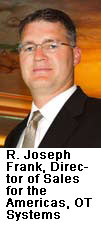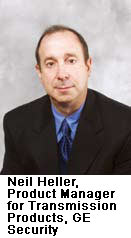Fiber optic transmission can transfer large amounts of data over a long distance. With today's advanced technology reducing material and installation costs, fiber optics has become more affordable. A&S takes a look at the latest technology that contributes to cost reductions and the future of fiber optics.
Fiber optic transmission can transfer large amounts of data over a long distance. With today's advanced technology reducing material and installation costs, fiber optics has become more affordable. A&S takes a look at the latest technology that contributes to cost reductions and the future of fiber optics.
While the global economic downturn has posed some negative effects on certain regions, sales of fiber optics in growth regions, such as Asia, Africa and the Middle East, have shown no immediate impact. In fact, APAC and EMEA are both showing steady growth, said Mark Marriage, CTO of COE.
New projects in those areas involve new public areas, transportation hubs, roads and large building complexes. Projects this large are funded up to a year or more in advance, said Calvin Wong, Director of Sales for EMEA, OT Systems.
In the U. S., the impact is more visible. "Many customers are still bidding for projects, but they are not releasing the final purchase orders as quickly. We find slowed growth as a result of reduced or eliminated capital improvement projects and frozen or reallocated budgets for noncritical infrastructure," said R. Joseph Frank, Director of Sales for the Americas, OT Systems.
 Another reason that has caused fiber optics' revenue to decline in the U.S. is market maturation. "Fiber optics has reached its maturity in the product life cycle and is beyond the growth curve, moving into a flattened market phase," said Roland Hooghiemstra, VP of Sales and Marketing, Optelecom-NKF. The decline in turnovers could also be a result of new players entering into the market, pushing down prices and leading to a lower, overall revenue stream, Hooghiemstra said.
Another reason that has caused fiber optics' revenue to decline in the U.S. is market maturation. "Fiber optics has reached its maturity in the product life cycle and is beyond the growth curve, moving into a flattened market phase," said Roland Hooghiemstra, VP of Sales and Marketing, Optelecom-NKF. The decline in turnovers could also be a result of new players entering into the market, pushing down prices and leading to a lower, overall revenue stream, Hooghiemstra said.
Benefits of Fiber Optics
Fiber cable is strong and has great tolerance to abuse. It has a smaller diameter and weighs less than copper. It is nonflammable, virtually impervious to tapping, and it is better suited for data and illumination transmission. A minimum long-term, low-stress radius for fiber optic cable is no less than 15 times the cable's diameter. The bending radius is more flexible then a Cat-5 cable, which can be bent four times of the cable's diameter. All these features make fiber optics ideal for a variety of cabling solutions, said Frank.
In terms of transmission capability, fiber optics has no problems with signal degradation over long distances, no induction or emission issues through lightning and no distance limitations, said Hooghiemstra.
Unlike certain signal transmissions, fiber does not affect the operation of sensitive equipment. Moreover, all electrical installations must abide by the NEC and NFPA rules and regulations. However, these rules are much less stringent when it comes to fiber optics since fiber optics is nonconductive.
 Hospitals and military installations can also benefit from fiber optics. For example, medical equipment in hospitals should not be influenced by camera signals and sensitive data needs to be protected in military applications, said Hooghiemstra.
Hospitals and military installations can also benefit from fiber optics. For example, medical equipment in hospitals should not be influenced by camera signals and sensitive data needs to be protected in military applications, said Hooghiemstra.
In general, types of applications determine the use of fiber optics. Outdoor applications that require stable signal transmission over a long distance often see fiber optics as the best solution. In many cities and newer commercial buildings where dark fibers (unused) are already in place, adoption of fiber can be quicker and cheaper, said Neil Heller, Product Manager for Transmission Products, GE Security.
Distance
Fiber optics enables a longer data transmission distance than both coaxial and Ethernet cables. "Coaxial cable (RG-59) has a distance limitation of 303 meters and should not be used for installations more than 227 meters. Twisted pair has a distance limitation of only100 meters. In many security projects these distances are too limiting. Fiber optics offers the ability to transmit signals more than 60 km, offering more flexibility and cost-effectiveness," said Heller.
Reliable Transmission
For commercial applications, the data transmission rate available today is up to  40 gigabits. Many new tests and trials are being successfully completed by different companies for 100-gigabit networks, said Frank.
40 gigabits. Many new tests and trials are being successfully completed by different companies for 100-gigabit networks, said Frank.
With fiber optics, reliability is another advantage. For a system made up of coaxial cables, electronic amplifiers are needed. However, each electronic amplifier is a source of instability for signal and power failures; the number of amplifiers needed can be reduced or eliminated.
For example, a TV system using coaxial may require up to 16 to 20 amplifiers to boost signals. By using fiber optics, no more than four amplifiers are needed, said Jim Hayes, President of the Fiber Optic Association.
Fiber optics is also immune to radio frequency interference (RFI) and electromagnetic interference (EMI), enabling an ideal solution with electronic devices that can cause RFI or EMI being put in close proximity, said Frank.
Cost-Effectiveness
The physical process of installing fiber optics is not always more expensive than copper if the network is required to carry large amounts of traffic. "While the hardware cost of a fiber-optic system is more than that of a copper-based system, fiber optics can easily transfer 20 times longer in distance and 500 times more in bandwidth. As a result, the cost of per unit of data is much lower," said Hayes.
Fiber optics is also more cost-effective when compared to compressed signal transmission. Real-time, uncompressed signals work better with video analytics when compared with some IP solutions, said Sara Bullock, Executive Sales Director, AMG Systems. While motion detection at the edge could solve bandwidth  limitations by transferring only the changed frames, compressed images cannot provide pixel-based recognition that yields higher accuracy. As processing power increases in the future, the cost could be very significant to upgrade all the cameras.
limitations by transferring only the changed frames, compressed images cannot provide pixel-based recognition that yields higher accuracy. As processing power increases in the future, the cost could be very significant to upgrade all the cameras.
Advanced technology such as wavelength division multiplexing sends multiple signals on a single fiber, making upgrades to terabits per second possible. Nowadays, 80 percent of the people in the U.S. who have broadband access are having it on cable TV channels, said Hayes. Fiber to the home (FTTH) is now a challenge for DSL worldwide, Hayes said.
R&D Advancements
The infrastructure cost of projects utilizing fiber optics could be very high, said Bullock. This is due to the nature of applications, such as highways and other wide-area projects, where digging up the ground is prohibitively expensive and often very inconvenient in terms of road/lane closures.
However, it is also true that both the material and installation costs for fiber optics have come down substantially over the past few years. Technological advancements have made fiber optics a less complex and a more affordable solution for many installations.
Termination Tool Kit
The biggest development which has reduced installation cost is the advancement in fiber-optic cable termination tool kits, said Frank. This eliminates the need for epoxy/polish connectors.
The no-epoxy/no-polish connector makes termination quick and easy. It provides huge labor savings, requires little technical training and offers very good connectivity. Installers only need to strip, cleave and lock the fiber into the connector body, which also contains a short prepolished fiber stub in the ferrule.
In effect, those are connectors with a built-in mechanical splice and a factory-controlled end face that provides return-loss performance for a field-terminated connector. While no-epoxy/no-polish connectors have been developed for more  than 15 years and have had many growing pains, recent cost models have shown that this connector technology can be the most cost-effective for field installations, said Frank.
than 15 years and have had many growing pains, recent cost models have shown that this connector technology can be the most cost-effective for field installations, said Frank.
Fusion splicing traditionally required expensive tooling to connect the fiber optic cabling in the field. New developments, such as mechanical splices, are now available to save the expensive tools previously needed, said Hooghiemstra. The connectors at the end of the fiber cable are also available in field-mountable versions while before it was inserted at the factory to a simplex fiber cable and connected in the field through fusion splicing.
Installation of fiber is generally considered to be easier than coaxial Cat-6, said Hayes.
Users today can even purchase plug- and-play prefabricated fiber packages. This is a major development, by Verizon and Cornings, which could change the way people live, Hayes said. Users can also find various solutions specifically designed for low-cost, multichannel transmission with Ethernet capabilities on the market today, said Bullock.
Architectures can be configured as a "ring" for a dual redundant configuration to ensure no loss of signals following a catastrophic fiber or node failure. By using coarse wavelength division multiplexing, up to 16 wavelength channels can be used to provide a transmission capacity of up to 128 video channels on one single mode optical fiber together with the associated data/audio and Ethernet, said Bullock.
When used in a dual redundant configuration, an eight-fiber ring has simultaneous capacity of up to 512 video channels, 1024 data/ audio channels and 6.4 gigabits per second of Ethernet, said Bullock. Some systems also send out alarms associated with the breaks in the optical fiber together with loss of video signals.
Transmitter and Receiver
In addition, active-end equipment, such as fiber transmitters and receivers, is becoming smaller, less complicated and easier to install. For example, fiber-optic converters used in analog video surveillance are designed for free maintenance, eliminating any need of onsite adjustments or alignments. Signal quality is well-preserved within the transmission range, requiring no AGC or any other dynamic controls, said Frank.
Future Outlook
In an age where "going IP" has become a mantra, it seems that uncompressed digital transmission still has something else to offer. As IP networks become the bases for security systems, larger amounts of data in the form of video files will be required. Fiber optics has a large and growing role because it is the preferred medium for high-bandwidth requirements, said Marriage.
Moreover, the push for video analytics that requires uncompressed video signals is helping the uptake of uncompressed, digital-transmission solutions. High-definition cameras entering the marketplace would also increase the uptake of fiber-optic solutions.
Fiber optics is also increasingly used in access systems. Although this section of the market has a lower revenue potential than the backbone system, access systems that previously were installed with coaxial and twisted-pair technologies  are now turning to fiber as the price becomes more affordable, Hooghiemstra said. In addition, "green" operation also favors fiber optics highly for high data rates and long-distance transmission, said Jesper Bek, CEO of IPtronics.
are now turning to fiber as the price becomes more affordable, Hooghiemstra said. In addition, "green" operation also favors fiber optics highly for high data rates and long-distance transmission, said Jesper Bek, CEO of IPtronics.
Aside from security installations, fiber optics can also be used in TV cabling, telecommunication and household intercommunication. One of the latest growing phenomena is the installation of FTTH. While FTTH is currently used for household Internet connections, usage for other household purposes could arise in the future, said Wong.
For example, in some high-tech apartments, residents can see from doorphones to know who is visiting at the lobby. Data from gas or water meters at homes can be sent to utility companies directly so no door-to-door visits would be required. Future expansions are allowed on the existing FTTH backbone if required. However, the Internet is still the key application at the home front, said Wong.
Another growing t rend for the use of fiber optics is in the consumer segment. Most consumer entertainment electronics include digital fiber links and controls, and entertainment systems used in cars use fiber optics for transmission, said Hayes.
Fiber optics will continue to grow in leaps and bounds as bandwidth requirements of communications, network and security systems continue to grow. A shift in cost structures regarding copper verses fiber is already occurring. Fiber optics is clearly the transmission technology for today and tomorrow, Wong said.